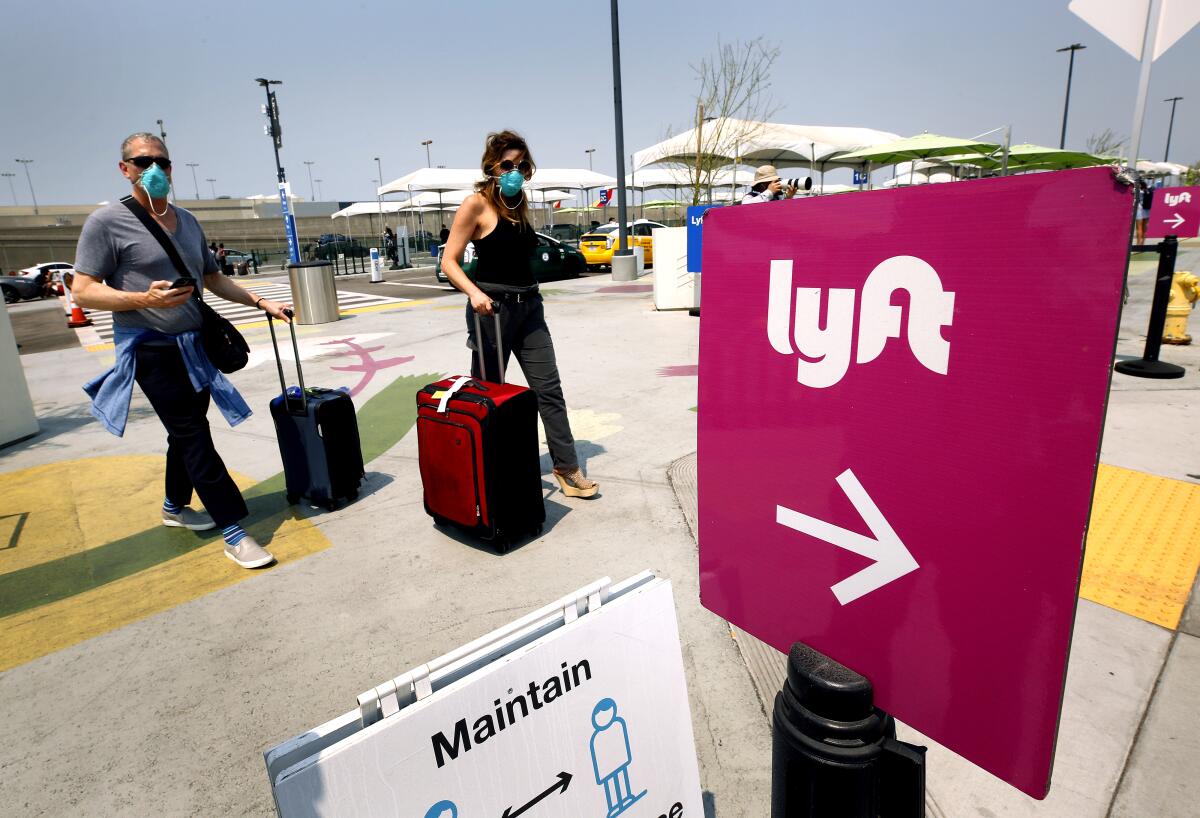How Uber and Lyft persuaded California to vote their way

- Share via
Six weeks before election day, Proposition 22 was in trouble.
Just 39% of likely voters surveyed in a UC Berkeley Institute of Governmental Studies poll said they would side with Uber, Lyft, DoorDash and other gig economy companies by voting yes on a California ballot measure that would override state law requiring them to treat workers as employees. A big chunk of voters, 25%, was still undecided.
On Nov. 3, Proposition 22 cruised to an easy victory with 58% of the vote, insulating gig economy companies from future regulatory threats and creating a legal framework to undergird their business model. How they turned the campaign in their favor is of great significance; in recent days, executives have already said they hope to replicate the process across the country.
Facing an uphill battle, Uber, Lyft and other gig economy companies set a spending record, pouring more than $200 million into the ballot initiative. They saturated TV and digital ad space. They bombarded gig workers and customers alike with in-app notifications and emails suggesting that drivers wanted to remain independent contractors and that a yes vote would be best for them.
The strategy seems to have worked, with the companies finding support across most of the state.
Yet the map of voter support is as decisive as it is confounding. Within Los Angeles, Proposition 22 was voted down in several liberal-leaning precincts but found widespread support in neighborhoods with large Black and Latino communities and majority white suburban areas alike. It breaks with oft-seen voting trends by uniting working-class South Los Angeles with the wealthy and conservative Beverly Hills.
Across the state, Proposition 22 found its strongest support in agricultural or rural counties far from the app companies’ biggest markets, such as Shasta and Glenn, which both passed the measure with 70% of the vote. It won Orange and San Diego counties with well over 60%, compared with 55% in Los Angeles. The measure faced its opposition in parts of the Bay Area, where Uber and Lyft are headquartered, with five of the nine counties in the region voting against it, and along the Northern California coast.
Securing yes votes on ballot measures is notoriously difficult because undecided or confused voters typically default to a no vote.
“It was surprising,” said Greg Ferenstein, research director at the nonprofit Tech4America and a former tech journalist. “I did not think it was going to pass because generally there’s a pretty big backlash against the tech industry, and a lot vote no on propositions, regardless of what it is.”
Uber and Lyft threatened to leave California or raise prices and cut jobs if the measure was voted down. Ferenstein said voters may have supported the measure because they feared the unpredictable consequences its failure would bring to companies, customers and drivers.
Mark DiCamillo, a veteran pollster at UC Berkeley’s Institute of Governmental Studies who conducted the main preelection polls, said that although voters who are undecided tend to break to the no side, this measure presented a unique quandary. A yes vote would maintain workers’ current status as independent contractors, while providing a few extra benefits such as a healthcare subsidy and minimum wage, depending on hours driven. A no vote would alter drivers’ employment status, which companies said would force them to restructure their businesses.
“For Prop. 22, keeping the status quo in this particular instance was actually a yes vote, and that, in my judgment, made a big difference,” DiCamillo said. “Voters weren’t of the mind to make big changes with app-based drivers, and the yes vote got the majority of people who were withholding judgment until the end.”
The yes campaign’s historic cash flow played a role in that. With $204 million, its war chest dwarfed that of the opposition by more than 12 to 1, making Proposition 22 the most expensive ballot initiative in U.S. history.
“It was impossible not to get exposed to their ads,” DiCamillo said. “The volume of advertising on the yes side was so great it actually worked to the detriment of some other ballot measures trying to communicate in the late stage to voters because a big chunk of messaging was being dominated by the yes campaign.”
Preelection polling showed there was no pronounced partisan divide between voters. And there was no clear indication that the union households polled opposed the measure, DiCamillo said. Labor unions — including Service Employees International Union, United Food & Commercial Workers and the Teamsters — led the unsuccessful campaign against Proposition 22, raising about $16 million.
“Only 51% of union households said they would vote no. I was surprised by that. It showed that the rank and file wasn’t following the lead of their leaders,” DiCamillo said.
Uber and Lyft referred questions regarding their strategy on Proposition 22 to the yes campaign. An eight-page report provided by the Yes on 22 campaign on the measure’s success offers some clues as to how it cut through the din of a pandemic and presidential election to persuade voters.
The report attributed the win to the campaign’s emphasis on providing freedom and flexibility to drivers, and its “great lengths to make driver voices the focus and face” in messaging. More than 120,000 drivers signed up to support the campaign, the report said, and numerous paid ads featured “driver voices providing a simple and easy-to-understand description of what the initiative would do.”
The report also credited assembling a “transcendent coalition” that “reflected the driver base, who predominantly represent communities of color,” touting endorsements from the state’s chapter of the NAACP, as well as California’s Hispanic, Black and Asian American chambers of commerce.
Opponents objected to the campaign’s claim that Proposition 22 would advance racial equity, saying it would stifle wages and highlighting the fact that a public affairs firm run by California NAACP’s president was paid $85,000 by the yes campaign.
A Times examination of precinct-level data in Los Angeles County shows the companies’ argument held sway in its dense core, finding support in lower income areas including plurality-Black neighborhoods such as Inglewood and Compton, and majority-Latino East Los Angeles. It also won suburbs in the San Fernando Valley, affluent communities such as La Cañada Flintridge, and rare Los Angeles precincts where President Trump was victorious in Beverly Hills and Santa Clarita.
A band of wealthy or increasingly affluent liberal-leaning neighborhoods stretching from Santa Monica and Venice, across to Los Feliz, Highland Park and South Pasadena mounted the strongest opposition, decisively voting down the measure.
Lane Kasselman, the former head of communications at Uber and a co-founder of crisis communications firm Greenbrier, which has worked with Lyft, said the split reflects a divide between those who are wealthy enough to use gig services and those who are or have been gig workers. The former would never work for gig services themselves but want workers to have the same rights they do, he said, while the latter “absolutely do not want the restrictions that come with employment.”
Others said it’s not that simple. Although the yes campaign argues its promises of certain benefits and current levels of scheduling flexibility resonated with voters, opponents said the campaign benefited from a deceptive framing.
Preliminary results from a Capitol Weekly survey of 23,500 voters who returned ballots by mail found that 40% of those who voted yes on Proposition 22 said their vote was ensuring drivers get a livable wage.
While the opposition campaign said it was pushing for greater benefits and protections for workers, the yes campaign took the air out of that argument by countering that it was providing “historic” new benefits — even though the suite of new benefits was objectively weaker than those provided to employees by state law, said Paul Mitchell, vice president of Political Data, who conducted the survey.
“The yes side co-opted the best message of the no side,” Mitchell said.
Nicole Moore, an organizer of L.A. driver group Rideshare Drivers United and opponent of the measure, said people have congratulated her on the passage of the measure and her work fighting for drivers at least three times over the last week, only for her to have to clarify her side lost.
“The yes campaign showed videos of single moms saying she wouldn’t be able to figure out how to make extra money for her family, so vote yes on Prop. 22. But in reality, she would have less in the bank under Prop. 22 than under basic labor law,” Moore said.
When Moore organized driver protests and car caravans by Los Angeles International Airport and the palatial homes of Uber founders in Beverly Hills, she heard support for pay and benefits. But it didn’t materialize in the voting booth.
“It’s hard because if you polled people and asked, ‘Do you think drivers get paid enough,’ people would say no, and if you asked, ‘Do they deserve basic minimum wage in California,’ most people would say yes. But that’s not how the question was posed,” she said.
As Uber and Lyft indicate plans to take their model national, opponents are looking for answers in progressiveSan Francisco, which roundly rebuked the measure with 60% voting no.
The measure was seen by San Francisco voters as a referendum on the companies behind it, said Jason McDaniel, an associate professor of political science at San Francisco State.
“The tech companies supporting Prop. 22 are quite politically unpopular here,” McDaniel said. “Many voters consider them responsible for many of the problems facing the city.”
It found support in neighborhoods associated with tech industry workers, such as the Marina and SOMA, but was defeated in the Mission District, the city’s Latino core, which has seen rampant gentrification fueled by tech industry wealth. While the industry has reshaped the city, its workforce does not dominate the electorate, McDaniel said.
Carlos Ramos, a longtime driver for Lyft, pointed to the labor group Gig Workers Rising and outspoken support for the no campaign from representatives such as Assemblyman Ash Kalra (D-San Jose) and Rep. Ro Khanna (D-Fremont), as well as from members of San Francisco’s Board of Supervisors.
“As we take stock of the wins and losses, we’re going to see why it was effective in the Bay Area and not as much in other places,” said Ramos, who organizes for Gig Workers Rising. “There’s a lot to unpack, and we’re going to do our best to focus on getting this information out.”









